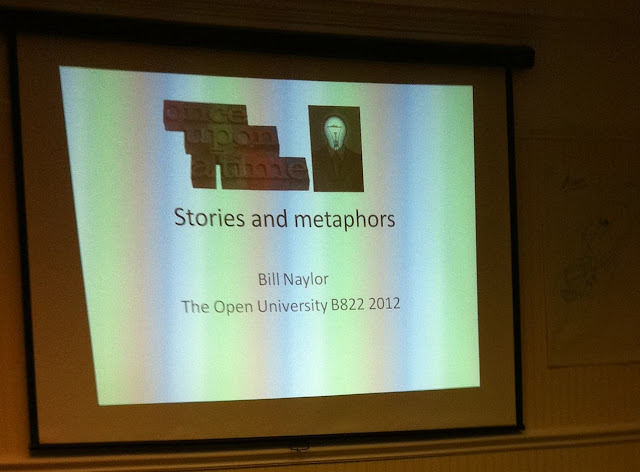From the B822 Techniques Library we learn that we relate to stories; the parallels to our own lives provide meaning.
I'd say that to be successful audiences must feel empathy with any story, whether for entertainment or to get attention in a business context.

Bill Naylor takes this well attended session.
He starts with the story of a Merchant
(I thought we were going to get the 'Merchant of Venice'. It felt like something from 14th century Italy, like a piece from Bocacio's Decameron).
The story concerned a merchant, his beautiful daughter and a money lender. Unable to pay back the loan the money lender suggests a deal, his daughter in marriage and the debt will be dropped. To help the merchant he offers to put two stones in a bag, one white, one black to be picked out by the daughter. It is agreed. The daughter happens to see the money lender putting two black stones in the bag. What does she do?
We offer our solutions, though none get the Merchant off the hook and save the daughter.
- Take none
- Take both
- Pick a pebble.
CHEAT
- Herself by picking up a white pebble and hiding it in her hand.
Transpose the rules
Actually she dropped the black pebble and said they'd know which one it was.
To create strategic clarity

"Stories stick in your mind like mental velcro." Naylor (2011)
- They create strategic clarity
- They create a connection
- They embed values
- They compel or inspire to take action
- They are revealing
- Stories connect us to a purpose and improve our performance
Quotes Henry V on the eve of The Battle of Agincourt
E.g. Chairman of the board.
STORYTELLING AT WORK
- An icebreaker
- Induction
- Communications
- Learning. (Boje 1991)
- Strategy
- Action
A story usedby De Bono about Columbus
Egg on its end. Breaks the tip so that it would stand on its end. Once done anyone can do it.
- Story of a young character on his first day having a word with a gruff character on the train in.
- The story of the fat man in the bath in relation to consumer law and returned products, in this case a bath that had sat for 5 months. Bill at a builder's merchants.
- Splintered toilet seat. The lady had a history of such issues.
- The thin man in the shower. Covered in soap he couldn't turn it off.
SPECTRUM
- Little s
- Anecdotes
- Examples
- Rcounts
- Big S
- Movies
- Epics
IMAGE
VS. The uncanny valley of business story telling ... Plummets.
ELEMENTS
- Characters
- Plot
- Conflict
- Resolution
MYTHICAL THEMES
- Creation
- Struggle for self-discovery and identity
- Battles, warriors, heroes (building of the M62)
- Jack Welch 'neutron bomb' Manager of the Century. 'Winning' Topping and tailing'
- Finance the top, ditch the bottom. (not unlike Steve Jobs)
- Love, self-sacrifice, dedication
- Wisdom and maturity
Three Huberts on a hill, three rivals.
Owns a race horse, only half, which half? The rear end as it eats less.
WHERE USED
- Induction
- Formal and informal settings
- Before an event
- Teaming courses
- Newsletters
- Customer meetings
- Social events
- Team building sessions
Left brain right brain
(Simplistic and superseded?)
HOW STORIES WORK
- Auditory types NLP
- Absorbed playfulness (winnicott, 1972)
- An excursion from the problem.
- Stimulate new ideas
- Convey hidden messages (do you tell them or leave them to dwell on it)
- Enable uncurious learning
De Bono's 'Thinking Hats'
- Unsconscious
- Feta on the verge of sleep (best for learning)
- Relaxed awareness (best for learning)
... Achieved through story telling, with learning supported by light music.
CAVEAT
- Stuck in the metaphor
- Persuasiveness of advertising
WORKSHOP
- Participants write the first line of a story that others complete. John Brucker on metaphor.
- Write an essay 10 mins
- Draw a mind map of the story
Write a statement in 3 sentences of 5,7 and 5 syllables. (Japanese Haiku poetry form)
E.g. sales director or purchasing director, what is best for the company and what is best for me.
DEVELOP
- In pairs use why?
- Write a sentence on the problem
- Boundary examination
- Options for for As.
Jack welch
'My main job was developing talent. I was a gardener who provided water and other nourishment to our top 750 people. Of course I had to pull up a few weeds as well'. Jack Welch.
COMPONENTS OF THE METAPHPOR
- Topic : the original concept
- Vehicle
- Ground
- Tension
- Zolta Kovecses Metaphor: a practical introduction.
- John Brooker, yesand.biz
Joke
- Set up, and punch.
- Friend broken up with wife. With his best friend. Going to miss the friend.
SHOULD I QUIT MY JOB ?
- Metaphor: swimming Linguistic: Am I too far from the shore.
- With a systematic framework.
Mind Maps

Rich Pictures

FURTHER LINKS:
http://www.imagethink.net/